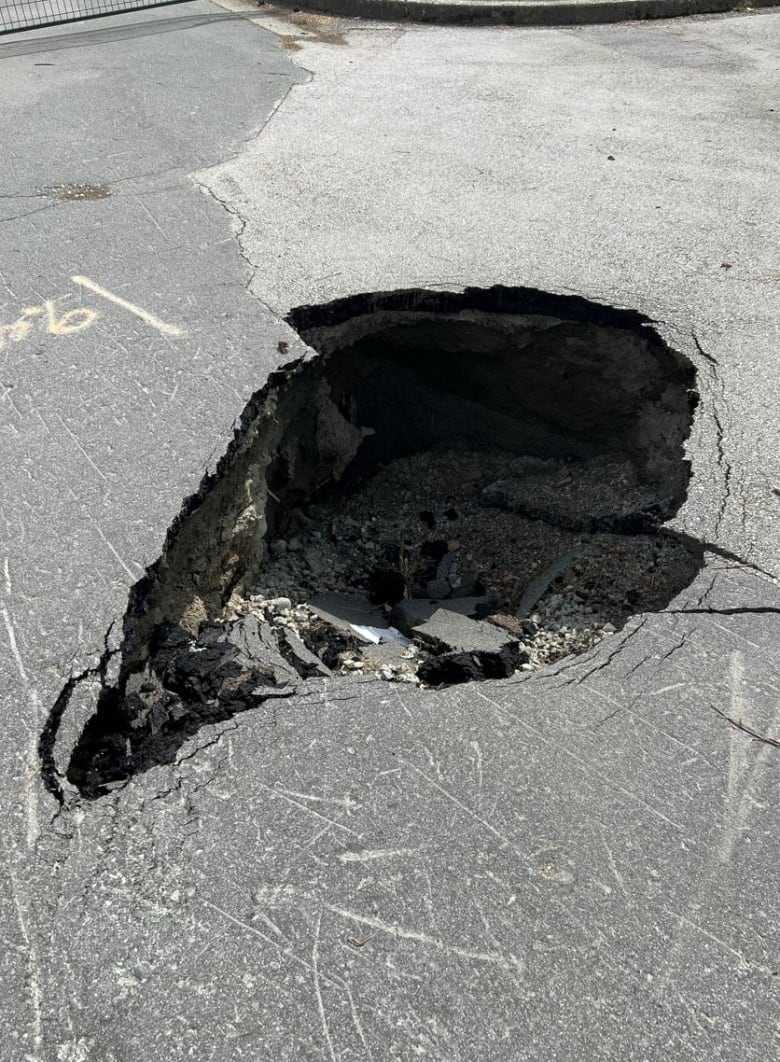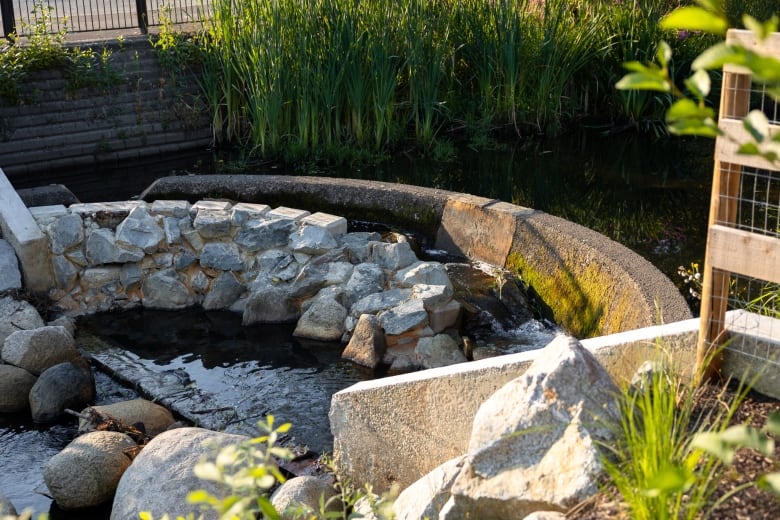B.C. creek buried by construction in the 60s restored
Dozens of ancient waterways across the Lower Mainland served salmon before they were paved over

Part of acreek that was buried under a post-secondary campus in Burnaby, B.C., decades ago has been brought to the surface again, in a bid to restoresome of the Lower Mainland's dwindling salmon habitat.
For thousands of years, chum salmon swam up Guichon Creek to spawn. But during construction of the Burnaby campus of the B.C. Institute of Technology (BCIT)in the 1960s, a 750-metre stretchof the waterway was sealed underground in a series of steel pipes and culverts, blocking passage for the fish.
Researchers say Guichon Creek, which feeds Still Creek, is one of dozens of ancient waterways across the Lower Mainland that served coho and chum salmon before they were paved over.
Over the past year, as part of an ongoing effort to restore Guichon Creek, the school uncovered part of the waterway in the hope that salmon would return.Thisfallis the first migration seasonthat salmon will be able to travel the length of Guichon Creek on their own.
Mark Angelo, former head of the Rivers Institute at BCIT, says he's been working to restore the creek for decades.
"It's wonderful," he said of the resurrected waterway. "I've been really excited. It was certainly cause for celebration."
City officials, researchers and university staff and students gathered outside the newly-restored section of GuichonCreek Wednesday to mark the milestone.
"Balancing the needs of a growing city with a thriving natural area doesn't happen by accident," Burnaby councillor Richard Lee said Wednesday. "It happens because of people like Angelo and experts strongly advocating for the health of these areas."
Still,there's no guarantee the fish will take to thenewly restored habitat.
"Anytime that we can bring creeks back up to the surface and recreate salmon habitat that used to exist, that's really beneficial," said David Scott, a biologist with Raincoast Conservation Foundation.
Across the country, many such creeks have been lost to development, he added, with cities rising above the rivers, brooks and streams that once supported wildlife and provided food and transportation for communities.
'Adead stream'
Angelo said when he first stumbled across what was left of Guichon Creek in 1974, it was in "terrible shape."
"It had been stripped of stream-side vegetation. It was badly polluted. It was filled with garbage and debris. It was literally a dead stream," he said.
Since then, Angelo, with the help ofBCIT and the City of Burnaby, has spearheaded volunteer efforts to clean up the creek, and has led students and staff in planting thousands of trees and shrubs along its banks.
In 2021, the City of Burnaby installed a culvert that let fish swim through the creek where it runs under the Deer Lake Parkway.
But despite the efforts, salmon were still blocked on their migration bya two-metre spillway built to to push water into the underground pipe system.
Last year, a sinkhole spurred BCIT to take the next step in restoration.

Over decades, the creek slowly eroded the steel pipe through which it flowed. Then, it carried away the earth that supported the concrete above. In 2023, a three-metre hole collapsed into the ground near the school's recreation centre.
Joe Cosh, BCIT's director of facilities improvement, said the sinkhole was no surprise.
"That was the methodology of the 1960s and 1970s. It was cheaper, quicker and easier just to put a river in a pipe in the ground and pave itand say, 'we'll deal with it later,'" Cosh said. "Now, it's later."
Repairing the sinkhole became an opportunity for restoration. Cosh said BCIT already planned to bring the creek to the surface, and the cost of restoring the stream was close to what damage repairs would have cost.
Crews excavated a 25-metre section of creek buried near the gym. They switched out corrugated steel culvert pipes and steep concrete walls for astreambed.
"It's gorgeous now. It's going to be a jewel of the campus," Cosh said.
Where culverts were still needed, corrugated steel piping was replaced with concrete, shaped for fish to safely pass through. Crews installed a salmon ladder that will let chum travel pastthe site of the spillway.

But Scott, who is also a PhD candidate in Pacific salmon ecology at the University of British Columbia, says it will take several chum salmon lifecycles for researchers to see if salmon return to GuichonCreek regularly to spawn.According to the Pacific Salmon Foundation, each chum salmon lifecycle is about three to four years.
Still, he's hopeful.
"The amazing thing with salmon is that they can respond to restoration really strongly," he said.
'Back to life'
Back at BCIT campus, there's still work to do. Most of Guichon Creek's length under campus is still covered in concrete. The school plans to uncover more of the waterway in the coming decade.
Now retired, Angelo is still working on restoring the creek. But he saidhis work is not in vain and he's alreadyspotted eagles, ottersand even the occasional bear near the creek.
"Over the years, slowly but surely, we started to make headway," Angelo said. "The creek literally started to come back to life."













_(720p).jpg)


 OFFICIAL HD MUSIC VIDEO.jpg)
.jpg)



























































































